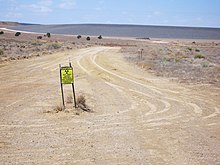
| External image | |
|---|---|
Ambrosia Lake is a uranium mining district in McKinley and Cibola counties in New Mexico north of Grants that was heavily mined for uranium starting in the 1950s. It is in an anticlinal dome.
History
Kerr-McGee first learned about rich uranium deposits in the area in 1955. It ran a free assay service and some prospectors had sent in samples that the company found to be high in uranium. Kerr-McGee sent an agent to buy the property. This agent instead double crossed the company and bought the site for himself. Various parties (including United Western Minerals Company of General Patrick Jay Hurley) rushed into the area to get sections of property. However Kerr-McGee wound up owning most of Ambrosia Lake.
Kerr-McGee then allied with Anderson Development Corporation, and Pacific Uranium Mines to form the Kermac Nuclear Fuels Corporation. They built a mill there. When Kerr-McGee Nuclear split into Quivira Mining and Sequoyah Fuels subsidiaries in 1983, Quivira got the Ambrosia Lake property. When Quivira was sold to Rio Algom in 1989, Rio got the mine and mill. Rio was later bought by Billiton which later became BHP.
Cleanup

By 1982, approximately 111 acres (0.4 km) of radioactive tailings were left from almost 25 years of uranium extraction. Wind and rain spread the material over an area of 230 acres (0.9 km). Between 1987 and 1995, the Department of Energy remediated the site, encasing 5,200,000 cu yd (4,000,000 m) of contaminated material in a 91 acres (0.37 km) disposal cell. While the DOE/UMTRA site is closed and inactive, the former Kermac mill (under BHP ownership) continues with reclamation activities towards final closure in 2021. Other cleanups at mine and mill sites in the area fall under the EPA's jurisdiction.
Notes
- ^ V. McLemore (Feb 2007). "Uranium Mining Resources in New Mexico" (PDF). SME Annual Meeting. Archived from the original (PDF) on 2009-09-20. Retrieved 2009-10-03.
- ^ "DECISION AND ORDER OF THE DEPARTMENT OF ENERGY". United States Department of Energy. 1997-03-13. Archived from the original on 2 September 2009. Retrieved 2009-10-03.
- ^ "Finding of No Significant Impact Related to Amendment of Materials License No. SNM-928, Kerr-McGee Corporation, Cimarron Fuel Fabrication Site, Crescent, Oklahoma". United States Environmental Protection Agency. 1999-08-02. Archived from the original on 2012-12-13. Retrieved 2009-10-03.
- ^ O'Dell, Larry. "NUCLEAR POWER". Encyclopedia of Oklahoma History and Culture. Oklahoma Historical Society / Oklahoma State University. Archived from the original on 2010-07-27. Retrieved 2009-10-02.
- ^ "Shiprock Mill Site". Energy Information Administration. 2005-10-09. Archived from the original on 16 October 2009. Retrieved 2009-10-02.
- ^ "Billiton Trumps Noranda, Codelco on Rio Algom Bid". Business News Americas. 2000-08-25. Archived from the original on 2016-03-03. Retrieved 2009-10-03.
- ^ "BHP/Billiton merger complete". Ferret, Australia's Manufacturing and Industrial Directory. 2001-04-07. Archived from the original on 2009-05-27. Retrieved 2009-10-03.
- Masters, Secret Riches, Chapter 6 - Ambrosia Lake
- "Ambrosia Lake, New Mexico, Disposal Site Fact Sheet" (PDF). United States Department of Energy. 2009-04-05. Archived (PDF) from the original on 14 October 2009. Retrieved 2009-11-06.
- "NRC: Rio Algom - Ambrosia Lake". www.nrc.gov.
- US EPA, REG 06 (25 September 2014). "Grants Mining District in New Mexico". US EPA.
{{cite web}}: CS1 maint: numeric names: authors list (link)
- John Masters (2004). Secret Riches: Adventures of an Unreformed Oilman. Gondolier Press. ISBN 1-896209-97-1.
See also
35°25′08″N 107°49′16″W / 35.419°N 107.821°W / 35.419; -107.821
Categories: